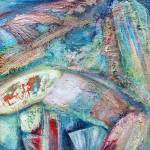Courtauld Gallery, London, 14 February – 27 May 2013
These are some notes that I made last year while visiting an exhibition at the Courtauld Gallery in London. The exhibition was based on the show that launched Picasso’s career in Paris in 1901. The suicide of his friend, Carles Casagemas, in that year created a period of reflection and introspection which, in his work, is known as the Blue Period.
I’m currently reviewing work undertaken for the portrait and figure module of the course so this post will focus on a small selection of the work on display that covered those subjects.
In some cases I haven’t been able to find a direct link to some of the images. In that case I’ve linked to a review of the exhibition which includes the image being discussed.
Self-portrait – Yo – Picasso, (1901) [External link]
While working with a chiaroscuro effect there is nothing subtle about this pose or the way the figure is set against the dark blue background. This contrasts with the vibrant yellow skin tones and the bold brushwork of the yellow and orange cravat.
The drama of the painting is achieved with a very limited palette – dark blues, yellows, orange, white and ochres – as well as thickly applied paint which creates contrasts of colour and texture. The pose, as an artist, and the challenging stare show his confidence at this early stage in his career. This is further emphasised with his signature, Yo – Picasso (I – Picasso).
Self-portrait – Yo [External link]
This self-portrait is in stark contrast to the previous painting. It was probably produced at a point when Casagemas’s death may have begun to impact on Picasso’s work. Again there is the use of chiaroscuro but it is subtler here. A darker palette of black and blue is countered by more realistic flesh tones. In this painting, unlike the three quarter profile of the earlier image, Picasso faces the viewer, and himself, full on. The challenging gaze is there but it is less assured. The loose brushwork gives the impression of a figure that is emerging, ghost-like, from the shadows which may be a reflection of how he was feeling in relation to the suicide of Casagemas.
Harlequin and companion, 1901 [External link]
This painting may have been a response to Degas’s painting In the café (absinthe) of 1875-76. Café society at the time had a colourful reputation but it was also a place of broken dreams, a place to go when there was nowhere else to go.
Picasso painted many of the characters who lived on the edges of society. In this painting he adds a twist by placing the comic characters of Harlequin and Columbine into Parisian cafe society at the beginning of the 20th century. Are we seeing Harlequin and Columbine or performers trying to eke out a living on the fringes of Bohemian society? It’s a visual sleight of hand which makes you, as the viewer, consider the lives of those who inhabited this world including aspiring actors, performers, musicians and artists.
Absinthe drinker (1901) [External link]
Another of those characters whiling away the day and night. In this case a woman sits alone lost in her own thoughts. Her position, at a corner table, and the way in which she wraps her right arm around herself portray someone who is alone and isolated from those around her.
Again the palette is limited, dark terracottas and pinks contrast with the blue of her dress and the syphon and glass on the table. I like the play of horizontals and verticals. The edge of the table and back of the banquette divide the painting, horizontally, into thirds while the vertical of the syphon echoes the stance of the figure and her hair.
Images
Picasso, Pablo, (1901) Self portrait (Yo – Picasso). [online image]. Available from: http://arttattler.com/archivepicasso2.html [Accessed 05/08/2014]
Picasso, Pablo, Self portrait (Yo). [online image]. New York: Museum of Modern Art. Available from http://www.moma.org/collection/provenance/provenance_object.php?object_id=80026 [Accessed 05/08/2014]
Picasso, Pablo, (1901) Harlequin and companion. [online image]. Moscow: State Pushkin Museum. Available from http://www.arts-museum.ru/data/fonds/europe_and_america/j/1001_2000/7191_Arlekin_i_ego_podruzhka_stranstvuyuschie_gimnasty/index.php?coll=9389 [Accessed 05/08/2014]
Degas, Edgar, (1976) In the cafe (absinthe). [online image]. Available from http://www.wikiart.org/en/edgar-degas/the-absinthe-drinker-1876 [Accessed 05/08/2014]
Picasso, Pablo, (1901) Absinthe drinker. [online image]. Available from: http://arttattler.com/archivepicasso2.html [Accessed 05/08/2014]






